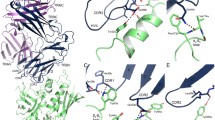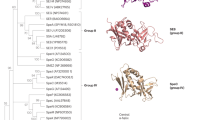Abstract
Streptococcal pyrogenic exotoxin A (SPEA) is an important pathogenicity factor of group A streptococci. It is a member of the family of „superantigens” produced by Staphylococcus aureus and Streptococcus pyogenes and its T lymphocyte stimulating activity is involved into the pathogenesis of certain diseases caused by pyogenic streptococci. In this study we have produced and characterized recombinant SPEA molecules in Escherichia coli. These molecules are indistinguishable from natural SPEA in both T cell stimulatory and HLA class II binding activities. Human class II molecules are more efficient than mouse class II molecules in presenting SPEA to T cells. In binding tests to major histocompatibility complex class II-positive cells SPEA competes with staphylococcal enterotoxin B and A but not with toxic shock syndrome toxin-1.
Similar content being viewed by others
References
Fleischer B (ed) (1992) Biological significance of superantigens. Karger, Basel
Marrack P, Kappler J (1990) The staphylococcal enterotoxins and their relatives. Science 248:705–711
Fleischer B (1994) Superantigens. APMIS 102:3–12
Fleischer B, Schrezenmeier H (1988) T cell Stimulation by staphylococcal enterotoxins. Clonally variable response and requirement for MHC class II molecules on accessory or target cells. J Exp Med 167:1697–1708
Janeway CA, Jr (1991) Selective elements for the Vβ region of the T cell receptor: Mls and the bacterial toxic mitogens. Adv Immunol 50:1–53
Mollick JA, Chintagumpala M, Cook RG, Rich RR (1991) Staphylococcal extotoxin activation of T cells. Role of exotoxin-MHC class II binding affinity and class II isotype. J Immunol 146:463–468
Scholl PR, Diez A, Geha RS (1989) Staphylococcal enterotoxin B and toxic shock syndrome toxin-1 bind to distinct sites on HLA-DR and HLA-DQ molecules. J Immunol 143:2583–2588
Chintagumpala M, Mollick JA, Rich RR (1991) Staphylococcal toxins bind to different sites on HLA-DR. J Immunol 147:3876–3881
Fraser JD, Urban RG, Strominger JL, Robinson H (1992) Zinc regulates the function of two superantigens. Proc Natl Acad Sci USA 89:5507–5511
Herman A, Labrecque N, Thibodeau J, Marrack P, Kappler JW, Sekaly RP (1991) Identification of the staphylococcal enterotoxin A superantigen binding site in the β1 domain of the human histocompatibility antigen HLA-DR. Proc Natl Acad Sci USA 88:9954–9958
Panina Bordignon P, Fu XT, Lanzavecchia A, Karr RW (1992) Identification of HLA-DR alpha chain residues critical for binding of the toxic shock syndrome toxin superantigen. J Exp Med 176:1779–1784
Karp DR, Tletski CL, Scholl P, Geha R, Long EO (1990) The alpha 1 domain of the HLA-DR molecule is essential for high-affinity binding of the toxic shock syndrome toxin-1. Nature 346:474–476
Thibodeau J, Labreque N, Denis F, Huber BF, Sekaly RP (1994) Binding sites for bacterial and endogenous retroviral superantigens can be dissociated on major histocompatibility complex class II molecules. J Exp Med 179:1029–1034
Jardetzky, TS, Brown JH, Gorga JC, Stern LJ, Urban RG, Chi YI, Stauffacher C, Strominger JL, Wiley DC (1994) Three-dimensional structure of a human class II histocompatibility molecule complexed with superantigen. Nature 368:711–718
Gerlach D, Köhler W, Knöll H, Moravek L, Weeks RC, Ferretti JJ (1987) Purification and characterization of Streptococcus pyogenes erythrogenic toxin type A produced by a cloned gene in Streptococcus sanguis. Zentralbl Bakt Hyg [A] 266:347–358
Jones CL, Khan SA (1992) Nucleotide sequence of the enterotoxin B gene from Staphylococcus aureus. J Bacteriol 166:29–33
Fleischer B, Gerardy-Schahn B, Metzroth B, Carrel S, Gerlach D, Köhler W (1991) A conserved mechanism of T cell Stimulation by microbial toxins. Evidence for different affinities of T cell receptor-toxin interaction. J Immunol 146:11
Weeks CR, Ferretti JJ (1986) Nucleotide sequence of the type A streptococcal exotoxin (erythrogenic toxin) gene from Streptococcus pyogenes bacteriophage T12. Infect Immun 52:144–150
Smith DB, Johnson KS (1988) Single-step purification of polypeptides expressed in Escherichia coli as fusions with glutathione S-transferase. Gene 67:31–40
Acolla RS (1983) Human B cell variants immunoselected against a single Ia antigen subset have lost expression of several subset. J Exp Med 157:1053–1061
Braun MA, Gerlach D, Hartwig UF, Ozegowski JH, Romagne F, Carrel S, Kohler W, Fleischer B (1993) Stimulation of human T cells by streptococcal “superantigen” erythrogenic toxins (scarlet fever toxins). J Immunol 150:2457–2466
Author information
Authors and Affiliations
Rights and permissions
About this article
Cite this article
Hartwig, U.F., Gerlach, D. & Fleischer, B. Major histocompatibility complex class II binding site for streptococcal pyrogenic (erythrogenic) toxin A. Med Microbiol Immunol 183, 257–264 (1994). https://doi.org/10.1007/BF00198459
Received:
Issue Date:
DOI: https://doi.org/10.1007/BF00198459




